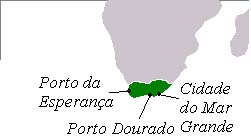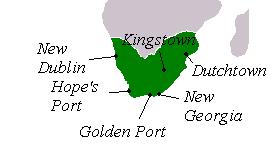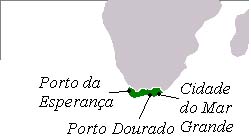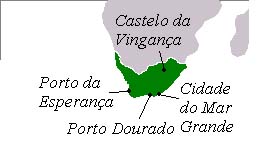The USA and a powerful Portuguese South Africa are major players on the world stage in 1914.
Timeline[]
The current year is 1914 but the national info table are all 2006.
Colonial History: Portugal 1608-1807[]
- 1608:The Dutch naval forces seize the Portuguese base on Mozambique Island. This leaves Portugal without a valuable stopping point to their trading sites in Asia.
- 1615: Colony of Porto Dourado (Port Elizabeth OTL) established. Evolves into Costa Dourado.
- 1630: Dutch attempt to take Porto Dourado fails. Large scale enslavement of local tribes. Expansion allows for development of ranches and farms. Immigration and birth rate steadily increases the population. Becomes port for acquiring food for trips to Asia. Large scale shipment of convicts to use as labor alongside slaves
- 1670: Crown colony of Costa Dourado stretches from Porto da Esperança (Port of Hope, OTL Capetown) to Cidade do Mar Grande (Town of the Great Sea, OTL East London). It has a population of about 7500 freedmen (merchants, craftsmen, soldiers, convicts, noblemen, farmers and ranchers) and about twice as many slaves. The population and wealth is mostly centered in Porto Dourado but the hidden money makers are the tea and sugar plantations.
- 1720: The decline of internal slave trade due to extreme depopulation of natives. In response Portugal Ships in slaves from East and West Africa, Brazil and a few from Asia. The new slaves and immigrants from Europe cause high social tensions as the colony expands farther into the interior. Population is about 60,000 total. Escaped slaves start to form bands and join with tribes. The planning of a road network to connect cities to outpost and to make settling the frontier easier.
- 1740:Through population growth and the buying of new parcels of land by rich plantation owners the colony increases its size by a half in the interior. Tribes of escaped slaves start acquiring guns. Population is 100,000

- 1760: Armed escaped slaves start to raid plantations and ranches for food and more guns. Population 130,000. First of three massive immigration waves begin as Costa Dourado's hidden wealth is slowly discovered. Immigration is largely from Portugal and Portuguese colonies in America. Brings approx. 50,000 people who dominantly settle on the coasts.
- 1780: The first major military operation in Portuguese South Africa begins. The royal army begins a five year campaign to root out escaped slave guerrilla bands and to add a large chunk of the interior to the colony. Costa Dourado now encompasses modern day Lesotho. Castelo da Vingança (Fort Revenge, OTL Pretoria) established. Population is 200,000.
Colonial History: Britain 1807-1836[]
- 1807: Britain invades and occupies Porto Dourado, renaming it The Royal Province of British South Africa. The name change is somewhat ironic at the time as the British population in Porto Dourado was essentially nil. Britain justified the act as a protective measure to keep the colony out of French hands but their true, unstated motives are to secure the colony for the trade routs to India and Asia.
- 1816: A young plantation owner named Jose Amaral discovers diamonds on his sugar plantation near Monte Nevoento (Foggy Hill(OTL Kimberly).
- 1817: The second massive wave of immigration to South Africa. This time it is composed of a large number of Irish, Scottish, Germans and Dutch, Asian Indians, convicts bound for Australia and Scandinavians. Increases Population by 75%, making it 455,000. Huge scale settlement of frontier as diamond mining towns spring up.
British start renaming campaign. Porto Dourado renamed Golden Port. Cidade do Mar Grande renamed New Georgia. Porto da Esperança renamed Hope's Port. Castelo da Vingança renamed Kingstown. New Dublin (which used to be called Baía dos Bois (Bay of Oxen) by the Portuguese) is the stopping point for the Irish and convict immigrants while Dutchtown is the stopping point of the German, Skandanavian and Dutch immigrants.

- 1818: The United States of America forces Spain to cede Puerto Rico and Cuba in exchange for limited monetary aid in the Chilean war of independence. This induces a new wave of expansionism in the US.
- 1822: Once again social tensions reach a breaking point in RPBSA as immigrants and the native Portuguese fight over land. Vigilantes and militias spring up.
- 1823: Full fledged rebellion erupts. Highly disorganized and under-armed, these small pockets of militia are more concerned with fighting each other than the British Army. The British sweep in and utterly rout the rebels. The colony is declared a military district and General James Smith is appointed Military Governor by Parliament (basically he is granted the power of dictator).
- 1824: Smith institutes the Treason Acts, which would basically make it illegal to be, in any way, against the British Empire. It would also make it illegal to challenge his authority.
- 1825: Smith institutes the Executive Act which would give him to power to execute anyone whom he saw as a threat to the Crown.
- 1828: Golden Port Massacre. Approx. 2000 people rounded up and shot in the back of the head for 'being disobedient'. Horrified by the act, Parliament impeaches Smith and replaces him with an old fashion Colonial Governor.
- 1834: The Parliament bans slavery in Great Britain and all of her territories, including South Africa. Huge riots break out among Portuguese population. As slavery is deeply ingrained in South African culture few a happy to give up this cheap labor source. Least is mining mogul Jose Amaral.
- 1835: Several large mining companies (unhappy with giving up their free labor) purchase cannons, rifles and ammunition as well as hiring mercenaries and conscripting their own private armies. The British, occupied in India, to too little too late to avert the growing crisis.
Rebellion to Revolution:1836-45[]
Founding and Growth[]
- 1841: A União de Sul África, known in English as The Union of South Africa, is established by General Pedro Dias. A Constitution is drafted by leaders of the 1836 revolution. It is heavily based on the United States constitution with a few exceptions (tricameral legislature and no electoral college are the biggest). Within months political parties spring up. The most powerful two are the Liberty Party (Partido Da Liberdade) and the Grand Africa Party (Partido de África Grande). The Liberty Party is left-wing and composed of Irish, Asians, freed slaves middle class Portuguese and city dwellers. The Grand Africa Party is a right-wing semi-fascist party composed of rural farmers and wealthy plantation owners.
- 1842: Pedro Dias is appointed Interim President by the three houses of Congress. He institutes a system of temporary indenture to boost the economy. To pay the soldiers who had fought in the rebellion Dias ceded huge tracts of 'uninhabited' land to soldiers, totally disregarding the native population. He repaid the debts owed to the USA and France with large amounts of diamonds.
The US uses these diamonds to purchase Canada which was devastated by the Rebellion of '41. This is received relatively well by most Anglo Canadians as they see it as their American cousins rescuing them from a clueless half-German Monarch.
- 1846: Jose Amaral is elected President. This highly contested election was between John MacDonald of the Liberty Party and Jose Amaral of the GAP.
Mexican-American war is finished with Mexico ceding the US California, Texas and the area made of by the Gadsden Purchase. First American trading post is established in Hawaii called Port Washington (OTL Pearl Harbor).
- 1854: The Kingdom of China is established by the Taiping Rebels. It is very week and plagued by bureaucratic problems. Despite the crippling troubles of the new dynasty, it receives aid and applause in the West.
- 1866: Abraham Lincoln, President of the United States, sees that if the US is to prosper after the devastating civil war she need foreign alliances. In his first major act since ending the war, he announced the Lincoln-Gomes treaty with South Africa. The nature of this treaty was to share military, scientific and economic strategies and materiels and to unilaterally declare war on any aggressor.
- 1873-75: American-backed rebellion is Hawaii. Republic of Hawaii formed. In 1875 Hawaii is annexed by the US.
The First Great War[]
What is to become the first truly world-wide conflict begins in , of all places, the African Congo. Four separate nations have land-claims on this territory: Great Britain, South Africa, Holland and Germany. Although GB and SA only half-heartedly support these claims (although both have contested claims on the East Central Territory (OTL Kenya, Tanzania, Rwanda and Burundi)), Germany and Holland are in an arms race, shipping soldiers, settlers, arms, money and supplies to better control this region.
May to September 1878[]
- May 18: A Dutch militia raids and pillages a German fort-settlement near OTL Mbandaka, killing all inside.
- May-June: The Dutch army occupies most of the German frontier settlements. The German Empire declares war on Holland on June 1.
June 26: The United Kingdom Declares war on Germany due to a defensive alliance with the Dutch.
July 9th: After the British seized a fort in the ECT South Africa declares war on GB.
Tensions Rising[]

A map of the world in 1914.
- 1884: Congress of Saint Petersburg: The Great Powers meet to put a end the the First Great War. The map of Africa and Asia is divided up by the colonial powers.
- 1886: The Grand Empire of China is established in China by the Peking Rebels. It is modeled on German Empire and takes steps to reform, modernize and industrialize China and relieve the social and ethnic tensions between the Chinese people.
- 1899-1901: Spanish-America War: US seizes the Philippines and Guam.
- 1900: The US purchases Greenland simply because it is in a competition with Russia for total land area.
- 1905: Japan conquers Chosen (Korea) and Formosa (Taiwan) with the consent of the US.
- 1906-10 Italo-Persian War: Italy seizes Iran after much fighting. Russians enter the war on the Italian side and conquers some of northern Iran.
- 1913: On April 8th the British Army opened up on peaceful Irish demonstrators in Dublin with machine guns. This is the first mass slaughter caught on film. This produces high Anglo resentment in the US and SA, as there is a large Irish minority in both countries.
- 1915: After a very bad famine, the people of Russia, under the Bolsheviks, revolt. The Russian royal family are killed.
See Also[]
- The First Great War
- The Second Great War
- Gobbling up Europe
- The Grand Depression
- The Third Great War
- The Silent War
- The Crumbling
- List of Nations


